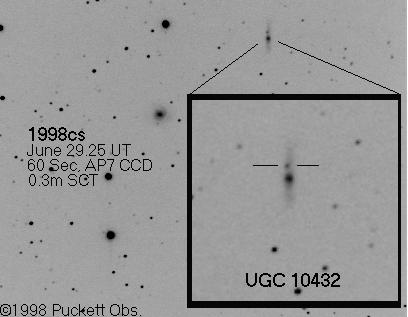Photoelectric Astronomy
The development of semiconductor technologies in the second half of the twentieth century led to exciting new detector technologies such as photomultiplier tubes and charged-couple devices (CCDs). These devices utilise the photoelectric effect to convert incident photons into a charge that can then be measured and recorded. CCDs have revolutionised astronomy in the last two decades, virtually replacing photography in professional astronomy. The sensitivity and power of CCDs has also seen them adopted by keen amateur astronomers whose backyard telescopes can now image objects once only obtainable on long photographic exposures on the world's largest telescopes.
Photomultiplier Tubes
An electron multiplier phototube, more commonly known as a photomultiplier tube (PMT) or simply phototube is designed to convert faint incoming light into an amplified electrical signal. The incident photons hit a photocathode made of a semiconducting photoemissive material such as gallium arsenide, dislodging electrons due to the photoelectric effect. These electrons are then accelerated down the evacuated tube by a series of positively-charged electrodes or dynodes at increasingly high electric potentials. At each electrode additional electrons are knocked out and are thus free to travel down the tube. The net effect is that a single electron dislodged by one photon from the original cathode ends up as a signal of 106 electrons at the final electrode where the signal is measured.
Photomultiplier tubes are therefore extremely useful amplifiers of weak signals. They can reach quantum efficiencies of up to about 20%, much higher than photographic emulsions. Another advantage they have is that their response is linear. This means that if you had double the number of incident photons you would have double the output signal. Photographic emulsions have a non-linear response.
By itself a photomultiplier tube can only measure the flux of incoming radiation. This makes it suitable for photometry where by using filters astronomers can measure the flux of a star at specific wavebands. With careful use photomultipliers can achieve photometric accuracy of about 1% (a difference of 0.01 magnitudes) but they are prone to interference from electric and magnetic fields and cosmic rays.
Photomultiplier tubes have largely been supplanted by CCDs as detectors on optical telescopes but they are still extremely useful in cosmic ray and neutrino detector arrays. Super-Kamiokande, a neutrino observatory buried deep within a mine in Japan uses 11,200 photomultiplier tubes each 50 cm in diameter, the largest tubes in the world. They are immersed in 50,000 tons of pure water and detect the faint blue glow of Cerenkov radiation. This is the radiation emitted by particles such as neutrinos that travel faster than the speed of light in a dense medium such as water. The photomultiplier tubes can amplify the signal of the Cerenkov radiation. They also measure the arrival time of individual signals very accurately so that the signal detected by multiple tubes can be analysed by coincidence timing to plot the trajectory of the incoming particle that caused the Cerenkov radiation.
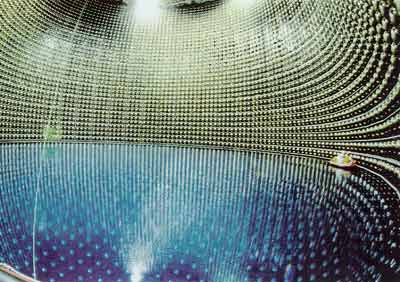
Super-Kamiokande's predecessor, Kamiokande, detected a flux of a few neutrinos from Supernova 1987a, the first definitive detection of neutrinos form a celestial source other than our Sun. Studies of solar neutrinos has provided an important test of models of nuclear reactions within the core. The Sudbury-Neutrino Observatory, SNO, another facility studying solar neutrinos is buried over 2 km deep in a mine in Canada. It, too uses photomultiplier tubes. The study of neutrinos and high-energy cosmic rays are examples of particle astrophysics, a branch of astronomy that is not reliant on electromagnetic radiation from the source.
Charged-Couple Devices (CCDs)
Originally conceived of as a memory module charged-couple devices or CCDs were soon adapted for other applications such as imaging. NASA's Jet Propulsion Laboratory took the first astronomical CCD image of Uranus in 1975. Since then the technology has been refined and come to dominate professional astronomical applications of imaging, spectroscopy, photometry and astrometry. Almost all professional observatories now employ CCD detectors where the may previously have used photography or photomultiplier tubes. Equally exciting has been the spread of powerful but affordable CCD cameras to the amateur astronomical community. Enthusiastic amateurs now have the ability using backyard telescopes to detect objects as faint as those at the limit of long photographic exposures on the world's largest telescopes only a few decades ago.
Apart from revolutionising astronomy CCDs are also widely used in other applications. The vast majority of digital cameras and digital video cameras around the world have a CCD as their detector (others use the related CMOS technology).
How CCDs Work
A CCD in basic terms is a thin sliver of a semiconducting material such as silicon arranged in a two-dimensional array of picture elements or pixels that use the photoelectric effect. If a photon of light hits a pixel the photoelectric effect causes an electron-hole pair to form. A small electrode can trap the electron in a potential well. As more photons hit the pixel, more pairs are formed and more electrons can be trapped in the well so that the total charge accumulates. Once the exposure is finished the charge in the well can be read out and the pixel reset ready for another exposure.
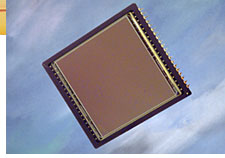
If we had a single-pixel CCD then it could measure flux from a source, much like a photomultiplier tube. CCDs however have a large number of pixels in a two-dimensional array. By reading out the charge in each pixel separately and matching it with its location spatial information is also obtained. The information is downloaded directly into a computer where it can be stored on disk and analysed using image analysis and processing software.
One common analogy used to describe the method of accumulating light and reading out charge is to consider a CCD as a series of buckets on a number of side-by-side conveyor belts. As it rains the buckets fill up with water but different buckets have different amounts of water in them. Once the exposure is finished (or the shower has passed), the first conveyor belt moves, emptying each bucket on it out in turn into a trough that runs to a measuring vessel. Once each bucket from the first belt has had its amount of water measured the second conveyor belt moves, emptying buckets in turn, then the third and so on. The amount of water in a bucket in analogous to the charge a CCD pixel contains at the end of an exposure. If a bucket gets filled up with water then some of it can spill out to the surrounding area. This too reflects what can happen on some types of CCD when the potential well fills up with the maximum amount of charge. Excess charge causes streaks (called blooming) on the read out signal. An example of this is when a CCD image is overexposed by a bright star.
Advantages of CCDs for Astronomy
- High Quantum Efficiency: Astronomical CCDs can reach peak quantum efficiencies of greater than 90%. This means that nine out of ten photons hitting a pixel form an electron-hole pair that can be detected and counted. Equally important is that CCDs have a high quantum efficiency across a wide waveband. A back-illuminated CCD for instance has QE > 60% for more a 500 nm waveband. CCDs are far more sensitive than either photographic emulsions of photomultiplier tubes. This means that they are much "faster" than photographic emulsions so that the same length exposure will reveal far fainter sources than a photograph. Shorter exposures therefore can often be used so that many more fields can be imaged in a single observing session.
The plot below compares the quantum efficiencies of different types of astronomical CCDs.
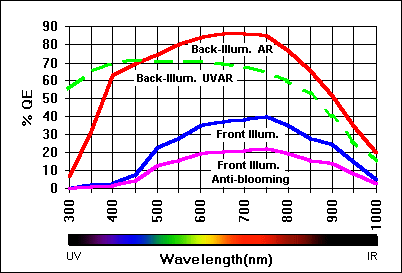 Credit: Apogee Instruments Inc.Plot comparing the quantum efficiencies of different types of CCDs used in astronomy.
Credit: Apogee Instruments Inc.Plot comparing the quantum efficiencies of different types of CCDs used in astronomy. - Broad Spectral Response: Early generation CCDs were sensitive in the red part of the spectrum but less so in the blue or ultraviolet regions. Improved technology means that current chips have a broader spectral response.
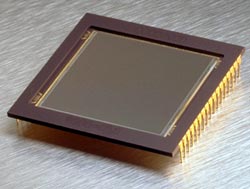 Credit: KodakKodak-16801E 16.8 million pixel CCD. This large professional-grade chip has extremely high resolution, low noise and a large dynamic range making it suited to astronomy.
Credit: KodakKodak-16801E 16.8 million pixel CCD. This large professional-grade chip has extremely high resolution, low noise and a large dynamic range making it suited to astronomy. - Large Dynamic Range: CCDs have a very large dynamic range. This is basically the range between the lowest and highest charge values that can be detected in a well. CCDs may have a dynamic range with a factor of 100,000 × compared with only 100 × that is typical for photographic emulsions. They are thus useful for imaging astronomical objects where there is naturally a large dynamic range in the sources.
- Linear Response: If a CCD pixel receives twice the number of photons than another pixel, it will have double the amount of charge than the first pixel. the number of electrons in a pixel therefore is proportional to the number of incident photons to within about 0.1%.
- Low Noise: As with any semiconductor material, the silicon in CCDs produces random "noise" due to thermal vibrations. This noise can degrade a signal. Fortunately modern CCDs are designed to produce very low levels of noise that can then be accounted for in subsequent analysis. One way of reducing noise is to cool the CCD chip - the cooler it is the less vibration in the atoms. Cooling can be thermoelectric (eg Peltier cooling) and/or by using cryogenic materials such as liquid nitrogen.
- Stable: CCDs are physically very stable. They do not expand or warp due to thermal or mechanical changes. The actual photosensitive chip is normally encased in a protective enclosure.
- Digital Readout: The information obtained in a CCD exposure is directly readout into a computer or digital storage device at the end of the exposure. This means that analysis can start straight away without the need for developing a plate as photography requires. It also avoids the need for scanning and digitising plates. The CCD data can be easily backed up on tape or disk and even transmitted via the Internet.
Problems with CCDs for Astronomy
The many advantages of CCDs ensured their rapid acceptance by the professional astronomy community. Although they are now the main detector used in optical astronomy they do have some disadvantages.
- Small Size and Field of View: Initially CCDs were quite small, a 512 × 512 pixel CCD with a total of 262,144 pixels was considered large. The problem with such small area detectors is that they give a very small field of view, much smaller than a photographic plate achieved on the same telescope. As manufacturing techniques have improved and the cost per pixel decreased, CCDs have grown in size. 1024 × 1024 pixels are now standard whilst chips with 4096 × 4096 (that is 16.8 million) pixels now exist. Nonetheless the field of view is still smaller than photographic systems. To try and get around this some observatories use several CCDs mosaiced together to give a much larger field of view.
One example of this is the wide-field imager, MegaCam which consists of 40 2048 x 4612 pixel CCDs (a total of 340 megapixels). This covers a full 1° × 1° field-of-view with a resolution of 0.187 arcsecond per pixel and makes the most of the 0.7 arcsecond median seeing at Mauna Kea. MegaCam sits at the prime focus of the CFHT, the Canada-France hawaii telescope, a 3.6 m optical telescope in Hawaii. - Cost: Professional-grade CCD chips are expensive. The cost per pixel has decreased significantly since their introduction but the chips used for professional astronomical CCD cameras have much higher specification levels and finer tolerances than those used in many commercial cameras.
- Calibration: In order to extract the information accurately and fully from a CCD images many calibration and adjustment steps are required. Additional frames or exposures such as flat-fields and dark frames must be taken and accurately logged. A CCD's performance also changes with temperature so this needs to be accounted for.
- Cooling: To minimise noise on an astronomical image a CCD chip must be cooled. If this involves cryogenic materials such as liquid nitrogen this must be added to the camera well in advance of observing to allow sufficient time for it to cool down. Care must also be taken to ensure the camera stays cooled.
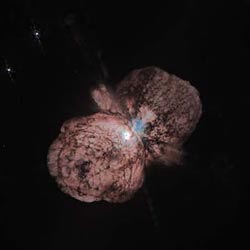
A close up image of η Carinae taken by the HST using a CCD. The expanding, ejected bipolar shell of gas can be clearly seen. Compare this image with the drawings and photographs of the same object at a wider field of view on the previous page. Click here for more detail from the press release.
